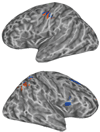Hearing lips and seeing voices: how cortical areas supporting speech production mediate audiovisual speech perception
- PMID: 17218482
- PMCID: PMC2896890
- DOI: 10.1093/cercor/bhl147
Hearing lips and seeing voices: how cortical areas supporting speech production mediate audiovisual speech perception
Abstract
Observing a speaker's mouth profoundly influences speech perception. For example, listeners perceive an "illusory" "ta" when the video of a face producing /ka/ is dubbed onto an audio /pa/. Here, we show how cortical areas supporting speech production mediate this illusory percept and audiovisual (AV) speech perception more generally. Specifically, cortical activity during AV speech perception occurs in many of the same areas that are active during speech production. We find that different perceptions of the same syllable and the perception of different syllables are associated with different distributions of activity in frontal motor areas involved in speech production. Activity patterns in these frontal motor areas resulting from the illusory "ta" percept are more similar to the activity patterns evoked by AV(/ta/) than they are to patterns evoked by AV(/pa/) or AV(/ka/). In contrast to the activity in frontal motor areas, stimulus-evoked activity for the illusory "ta" in auditory and somatosensory areas and visual areas initially resembles activity evoked by AV(/pa/) and AV(/ka/), respectively. Ultimately, though, activity in these regions comes to resemble activity evoked by AV(/ta/). Together, these results suggest that AV speech elicits in the listener a motor plan for the production of the phoneme that the speaker might have been attempting to produce, and that feedback in the form of efference copy from the motor system ultimately influences the phonetic interpretation.
Conflict of interest statement
Figures




Similar articles
-
Primary and multisensory cortical activity is correlated with audiovisual percepts.Hum Brain Mapp. 2010 Apr;31(4):526-38. doi: 10.1002/hbm.20884. Hum Brain Mapp. 2010. PMID: 19780040 Free PMC article.
-
Neural Mechanisms Underlying Cross-Modal Phonetic Encoding.J Neurosci. 2018 Feb 14;38(7):1835-1849. doi: 10.1523/JNEUROSCI.1566-17.2017. Epub 2017 Dec 20. J Neurosci. 2018. PMID: 29263241 Free PMC article.
-
Audiovisual speech integration does not rely on the motor system: evidence from articulatory suppression, the McGurk effect, and fMRI.J Cogn Neurosci. 2014 Mar;26(3):606-20. doi: 10.1162/jocn_a_00515. Epub 2013 Nov 18. J Cogn Neurosci. 2014. PMID: 24236768 Free PMC article.
-
Sequential audiovisual interactions during speech perception: a whole-head MEG study.Neuropsychologia. 2007 Mar 25;45(6):1342-54. doi: 10.1016/j.neuropsychologia.2006.09.019. Epub 2006 Oct 25. Neuropsychologia. 2007. PMID: 17067640
-
Towards a somatosensory theory of speech perception.J Neurophysiol. 2022 Dec 1;128(6):1683-1695. doi: 10.1152/jn.00381.2022. Epub 2022 Nov 23. J Neurophysiol. 2022. PMID: 36416451 Free PMC article. Review.
Cited by
-
Examining the McGurk illusion using high-field 7 Tesla functional MRI.Front Hum Neurosci. 2012 Apr 19;6:95. doi: 10.3389/fnhum.2012.00095. eCollection 2012. Front Hum Neurosci. 2012. PMID: 22529797 Free PMC article.
-
Decoding of Covert Vowel Articulation Using Electroencephalography Cortical Currents.Front Neurosci. 2016 May 3;10:175. doi: 10.3389/fnins.2016.00175. eCollection 2016. Front Neurosci. 2016. PMID: 27199638 Free PMC article.
-
The brain's dorsal route for speech represents word meaning: evidence from gesture.PLoS One. 2012;7(9):e46108. doi: 10.1371/journal.pone.0046108. Epub 2012 Sep 26. PLoS One. 2012. PMID: 23049951 Free PMC article. Clinical Trial.
-
Combined predictive effects of sentential and visual constraints in early audiovisual speech processing.Sci Rep. 2019 May 27;9(1):7870. doi: 10.1038/s41598-019-44311-2. Sci Rep. 2019. PMID: 31133646 Free PMC article.
-
Multisensory effects of mask wearing on speech intelligibility and the benefit of multilingualism.Codas. 2023 Sep 15;36(1):e20220341. doi: 10.1590/2317-1782/20232022341en. eCollection 2023. Codas. 2023. PMID: 37729326 Free PMC article.
References
-
- Abbs JH, Sussman HM. Neurophysiological feature detectors and speech perception: a discussion of theoretical implications. J Speech Hear Res. 1971;14:23–36. - PubMed
-
- Barlow HB. Single units and sensation: a neuron doctrine for perceptual psychology? Perception. 1972;1:371–394. - PubMed
-
- Barlow HB, Narasimhan R, Rosenfeld A. Visual pattern analysis in machines and animals. Science. 1972;177:567–575. - PubMed
-
- Belin P, Zatorre RJ, Ahad P. Human temporal-lobe response to vocal sounds. Brain Res Cogn Brain Res. 2002;13:17–26. - PubMed
-
- Belin P, Zatorre RJ, Lafaille P, Ahad P, Pike B. Voice-selective areas in human auditory cortex. Nature. 2000;403:309–312. - PubMed
Publication types
MeSH terms
Grants and funding
LinkOut - more resources
Full Text Sources
Medical

